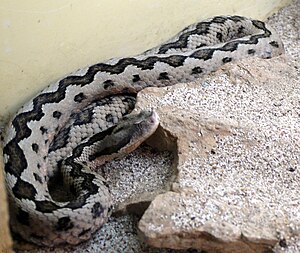Inverted viper
| Inverted viper | ||||||||||||
|---|---|---|---|---|---|---|---|---|---|---|---|---|

Inverted-nosed viper ( Vipera latastei ) |
||||||||||||
| Systematics | ||||||||||||
|
||||||||||||
| Scientific name | ||||||||||||
| Vipera latastei | ||||||||||||
| Boscá , 1878 |
The inverted nosed viper ( Vipera latastei ) is a venomous snake from the family of vipers (Viperidae). The scientific name honors the French zoologist Fernand Lataste (1847–1934).
features
The snake becomes 45 to 60, sometimes just over 70 centimeters long. It has a gray, brownish or olive green base color. Similar to the adder , they have a characteristic zigzag mark on their back , which is lighter on the inside. Since the distribution areas of the otters do not overlap anywhere, they cannot be confused.
Male inverted-nosed vipers are usually lighter, their back markings, which are dark gray or dark brown in females, are black. Evertnose vipers have small, dark spots at regular intervals on the side. The heart-shaped head is clearly separated from the neck. At the front of the snout it has a soft, horn-like outgrowth, to which it owes its German name. On the top of the back of the head are two dark spots. A dark band extends between the eyes and the corners of the mouth.
Distribution and subspecies
Two subspecies of the inverted nosed viper are known:
- V. l. gaditana (Saint-Girons, 1977) lives on most of the Iberian Peninsula with the exception of the northern coastal region bordering the Bay of Biscay . The focus of the occurrence is on the southern edge of the Pyrenees , in the Iberian Mountains , the Iberian Scheidegebirge , the Montes de Toledo , the Sierra Morena and the Betic Cordillera . In Extremadura and in the south of Galicia , the Vipera Latastei is only sporadically widespread. It is missing in the Balearic Islands . In Portugal , too , the inverted-nosed viper lives mainly in mountainous, isolated areas.
- V. l. latastei (Bosca, 1878) lives in southern Spain and Portugal, as well as in Morocco and Algeria in the Rif , the Middle Atlas and the Tell Atlas . In north-western Tunisia it reaches the Medjerda .
Both subspecies prefer hilly or mountainous areas and stay on rocks, between bushes and in dry forests.
The inverted nosed viper is very rare today. Its current area of distribution is very strongly influenced by human influences. It is highly fragmented, and many populations are very small and isolated. Populations in the lowlands have died out due to urban development and intensive agriculture.
habitat
The Vipera Latastei is particularly present in certain altitude zones a typical winter damp and summer dry Mediterranean climate appropriate location Air have. She avoids man-made cultural landscapes. They only inhabit the lowlands, just above sea level, when human influence is minimal, for example in dune areas. Your living space must offer cover and be rich in structure.
It is most common in the mountains between 1200 and 1300 meters. The highest find was about 3030 meters in the Sierra Nevada .
Reproduction
Inverted-nosed vipers mate in spring, and in good weather also in autumn. First, the males measure their strength in comment fights by wrapping themselves around each other, straightening their front body and trying to push the opponent down. The weaker gives up after a while. The females initially flee from the males, but are pursued. When the female is ready to mate, the male first crawls over her back. Then mating occurs.
The animals are viviparous. The two to ten, 16 to 18 centimeters long young animals are born between August and October. The boys born together have an average of 50 percent of the mother's total weight. Immediately after birth, the young snakes tear their egg shells and moult immediately afterwards. They first feed on insects, later on lizards and mice. they reach sexual maturity when they are 30 to 40 centimeters long.
Danger
The inverted-nosed viper is most endangered by the destruction of its habitat by humans. In particular, the expansion of metropolitan areas, urbanization, road construction and intensive agriculture have led to the destruction of their habitat. Other anthropogenic factors are forest fires set by humans and afforestation with fast-growing forest trees such as eucalyptus . In addition, if they sunbathe on asphalt, they are endangered by car traffic. In Portugal, the heads of the inverted-nosed vipers are considered amulets, which are supposed to bring luck or ward off bad luck.
Short-toed eagles and ichneumons are the only proven natural predators of the inverted-nosed viper. In addition, wild boars , gorse cats , brown-breasted hedgehogs , lizard snakes and domestic animals such as domestic chickens and domestic pigs are likely to be dangerous to them.
literature
- Nikolaus Stümpel, José C. Brito, Hubert Saint Girons: Vipera (Viperea) latastei (Boscá, 1978) - inverted-nosed viper. In: Ulrich Joger, Nikolai Stümpel: Snakes (Serpentes). 3. Viperidae. Aula, Wiebelsheim 2005, ISBN 3-89104-617-0 (Handbook of Reptiles and Amphibians in Europe, Volume 3 / 2B) Pages 187-212.
- Ulrich Gruber: The snakes of Europe. Franckh, Stuttgart 1989, ISBN 3-440-05753-4 , pages 204-207.
- Ludwig Trutnau: poisonous snakes. Ulmer, Stuttgart 1998, ISBN 3-8001-7371-9 (Snakes in the Terrarium, Volume 2).
- Günter Diesener, Josef Reichholf: Steinbach's natural guide. Amphibians and reptiles. Mosaik, Munich 1996, ISBN 3-576-10697-9 .
Web links
- Photos of the inverted-nosed viper on www.herp.it
- Vipera latastei in The Reptile Database
- Vipera latastei inthe IUCN 2013 Red List of Threatened Species . Posted by: Jose Antonio Mateo Miras, Marc Cheylan, M. Saïd Nouira, Ulrich Joger, Paulo Sá-Sousa, Valentin Pérez-Mellado, Iñigo Martínez-Solano, 2008. Retrieved September 21, 2013.
